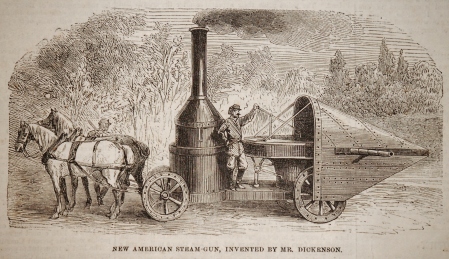Centrifugal Guns are class of weapons that flowered in 19th Century America. The idea was that by using man-power or steam engines one could rotate projectiles and fling them out upon an enemy with sufficient force to be deadly. Though they are called centrifugal guns, the should more properly be called centripedal guns.
The idea probably stemmed from that of the sling shot – a projectile is placed in a leather pocket and swung rapidly over the users head and released in the direction of the enemy.
Various guns used different means to move their projectiles – the Dickinson Gun fed shot into a barrel that rotated, the Joslin Gun (not yet profiled on this page) had a firing assembly that rotated on gear, other guns like the McCarty Gun used what is probably best described as a rotating arm. Another gun, not yet profiled, used an s shaped arm that pushed shells around the inside of a circular barrel.
While their inventors made wild claims for their guns, the laws of physics and other considerations would doom them. While the Winans Gun was in the press in 1861, the gentleman of the American Institute’s Polytechnic Association gathered on May 9, 1861 to discuss scientific matters, including centrifugal guns.
Though the discussion probably focused on the McCarty gun, then being demonstrated in New York several points touched on the problems that would impact all “centrifugal guns.”
A Mr. Dibben suggested that “ … the great difficulty in the use of the centrifugal guns is to give the balls the desired direction without impairing their momentum. The balls will all have the same direction, if the barrel is moved, horizontally; that is, they will all strike in a horizontal line; but the lateral deviation will be very great and uncertain, depending upon the velocity of the ball at the moment of discharge. It, therefore, becomes incapable of efficient service.”
He noted that he had witnessed a test of a disk- based centrifugal gun in which the first of series of shots …” went through an inch plank, at the distance of one hundred yards, but the last ones only indented it.” Dibben noted that “Every precaution is now taken in fire-arms to secure accuracy of aim. It is not now a question of one hundred yards, but of three or four hundred yards.
Vulnerable to Enemy Fire
“The steam gun is objectionable,” said Dibben, “not only on account of its inaccuracy of aim, but for its want of portability, and for its vulnerability. The boiler is a large mark, and a single shot from a fair distance would entirely destroy its operation.” A Mr. Nash concurred, saying that a “…steam gun could not be effective unless sheltered, for the moment a cannon ball touches it, there is an end to it. He described the execution which could be done with cannon, or even with rifles, by having a telescopic sight …”
Insufficient Force
Dibben noted that disk based centrifiugal guns imparted a rotating motion to shot, lowering its velocity.“Military authorities say that the bullet should have an initial velocity of 12 to 1,500 feet. With light rifles the speed probably reaches 2,000 feet. With such speed as that, the centrifugal gun falls into the background.
The discussion then turned to gunpowder. A Mr. Stetson noted that improvements in weapons allowed for throwing shot further with less initial force. Thirteen to fourteen ounces of powder would send a 12 lb Hotchkiss shell from half a mile to a mile. “The expansive force of gunpowder is very great, having been shown sometimes to amount to 100,000 lbs. [an editor’s note corrected this figure to 500,000] to the square inch,” Stetson said. “No such force as that of gunpowder can be produced by steam. Nor can we produce the centrifugal force due to such pressure without destroying the machine.”
Stetson explained in detail why velocity was a key limitation of centrifugal guns: “In order to throw a projectile with a given velocity, a force is required equivalent to lifting it a certain height, independent of friction, for that velocity will be expended in raising it that height; or, inversely, if it is allowed to fall from that height, in a vacuum, that velocity will be produced. To produce a double speed in any mass requires a quadruple power, the power required being in the ratio of the square of the velocity. It is thought by some that we may be able, with centrifugal guns, to throw bullets at the initial velocity of six hundred feet, which will kill at short ranges. But we cannot throw a stream of bullets like water through a hose pipe, with that velocity; for merely to overcome the inerta of the balls, a horse-power will only throw 1 J-ounce balls at the rate of one per second ; and we must have several horse-powers to overcome the friction. If the machine is small and convenient, the number of bullets thrown must be necessarily very small.”
Water Use
Though not mentioned in the discussion at the Polytechnic Association, using a steam powered weapon in combat would require the provision of considerable amounts of fuel and water. While combustible material of all sorts may be easily found, having sufficient water available would also be a challenge. Finding water for the troops often proved a challenge, let alone keeping enough water at hand to keep a steam gun running. While artillery pieces of the day were by no means light, they were portable and packed a devastating punch. They were efficient and used comparatively small amounts of powder to throw shells over long distance. In the hands of trained gunners they could have precision accuracy. They had no boilers to leak, pipes to break, gearing to jam, or complicated moving parts. They were brutally efficient at the work of killing.
Though many inventors explored the idea of a Centrifugal Gun in the days prior to the Civil War, their work would come to nought, as gunpowder based rapid fire weapons saw limited service during the war. These guns – the Coffee Mill Gun, and the ultimately more successful Gatling Gun marked the beginning of era in warfare – the birth of the modern machine gun.
[Key Source: Annual Report of the American Institute, 1861]



